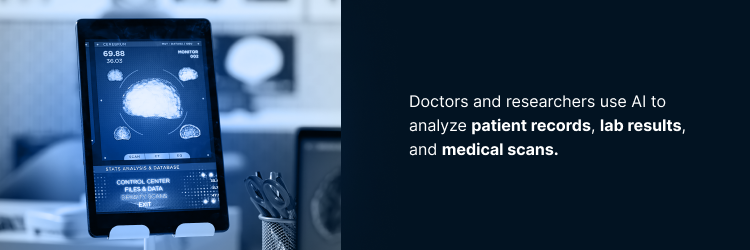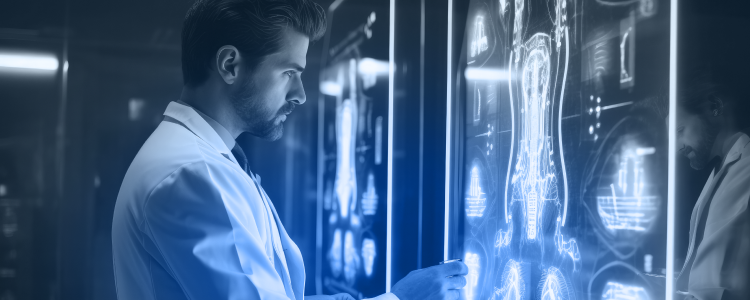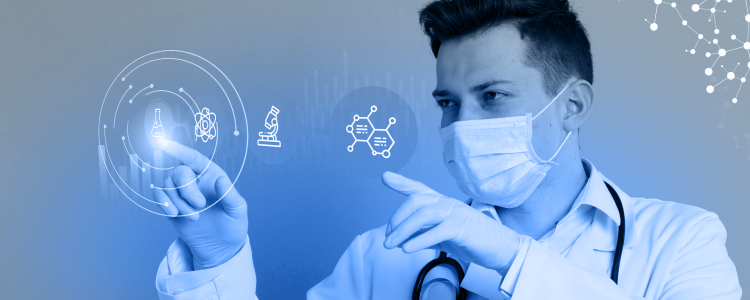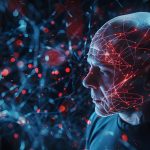
Artificial intelligence is changing how healthcare works. It’s not just chatbots or robots; it’s now part of real clinical practice. AI tools help doctors with diagnosis, treatment plans, and patient records management.
Healthcare AI supports every step of patient care. It spots diseases faster, suggests treatments, and keeps medical data organized. It also helps with drug discovery and tracks patient progress over time.
A report by Deloitte says 80% of hospitals now use AI in their healthcare systems. These tools improve patient care and make daily tasks easier for medical staff.
AI in healthcare uses machine learning, natural language processing, and other smart tools to speed up decisions. This article shows how artificial intelligence works in health care and how it helps patients and providers.
6 Ways AI Is Transforming Healthcare

From early disease detection to virtual health assistants, AI tools are helping doctors work faster, cut costs, and make smarter decisions. Here are six clear healthcare AI examples that are making a real impact.
1. Improving Disease Diagnosis
AI algorithms help doctors catch diseases early by spotting patterns in patient data. These tools read electronic health records and symptoms to suggest possible conditions.
They also scan medical images, such as X-rays or MRIs, to find signs of tumors, infections, or fractures. This boosts medical diagnosis accuracy and speeds up care.
2. Enhancing Drug Discovery and Development
AI is speeding up the drug development process. What used to take years can now happen faster and for less money.
AI models review huge sets of medical data, from clinical trials to genetic information. This helps researchers find drug targets and run testing simulations before going to the lab.
AI-driven platforms like Insilico Medicine use data modeling to create new treatments, such as drugs for rare lung diseases. These healthcare AI tools are cutting costs and saving time in drug discovery.
3. Supporting Clinical Decision Making
AI systems help support clinical decision-making by sorting through clinical data. They highlight patterns that can guide treatment plans.
For example, AI can suggest care options based on test results, medical history, and patient records. It can even flag risks before complications arise.
This gives healthcare professionals the insight they need to act fast and with confidence, especially in high-stakes situations.
4. Automating Administrative Tasks
AI tools save time by handling repetitive tasks, so healthcare providers can focus more on patients.
Here’s how AI supports clinical workflows:
- Scheduling patient visits and follow-ups
- Billing and managing insurance claims
- Updating electronic health records (EHRs)
- Handling data entry with fewer mistakes
5. Personalized Treatment and Precision Medicine
AI helps doctors create custom treatment plans. It analyzes health data, medical history, and patient-specific data, such as genetics.
This allows for care tailored to each person’s condition. The result is better outcomes, fewer side effects, and smarter medicine use through precision care.
6. Monitoring and Remote Care
AI is improving patient care outside of hospitals. Remote patient monitoring uses devices that track vital signs in real time.
Virtual assistants check symptoms, advise, and alert doctors if something looks wrong. These tools help manage chronic conditions at home and support quick care when it’s needed most.
Benefits of AI in Healthcare
AI in healthcare boosts patient outcomes, speeds up care, and cuts costs. It helps doctors work faster and more accurately. Here’s how it improves healthcare delivery:
- Faster, more accurate diagnosis: AI finds patterns in patient data, helping doctors diagnose health issues sooner and more reliably.
- Predictive analytics: AI tools spot early signs of disease. They help prevent problems before they get worse, leading to better health outcomes.
- Better clinical decision-making: AI suggests treatment plans based on patient history and lab results, supporting more personalized and effective care.
- Virtual assistants and remote monitoring: These AI tools track symptoms, send reminders, and monitor conditions in real-time. They improve care without needing in-person visits.
- Fewer admin tasks for staff: AI automates scheduling, billing, and records, saving time and lowering healthcare costs.
- Faster drug discovery: AI scans medical data to find promising treatments quickly, speeding up the development of new medicine.
AI in Clinical Practice: Real-World Applications
AI systems are already active in clinical practice. They help healthcare professionals provide better care using smart tools.
- Merative (formerly IBM Watson Health): Supports clinical decisions with data-driven insights.
- Google DeepMind’s CoDoC: Decides when to trust AI predictions or leave choices to doctors.
- AlphaFold: Predicts protein shapes to speed up drug research.
- H2O.ai: Uses electronic health data to build treatment plans.
- DeepView (Spectral AI): Analyzes wounds and predicts healing.
- Pfizer: Uses AI for drug trials and research.
- Biofourmis: Tracks health remotely and predicts problems early.
- eMed: Offers home testing and diagnostics using AI systems.
These examples show how AI improves diagnosis, supports mental health care, and streamlines clinical workflows.
AI and Health Data: How It’s Used

Doctors and researchers use AI to analyze patient records, lab results, and medical scans. Instead of manually going through the data, AI picks up patterns that could point to early signs of illness or risks that need attention.
Clinical research helps sort medical data, find eligible participants, and predict how treatments might work based on past results. This speeds up the process and makes the research more accurate.
Health planners use AI to track disease trends, plan resources, and improve services. By identifying patterns in healthcare data, they can make better decisions that actually match patient needs.
The Role of AI in Patient Care and Outcomes
AI in healthcare isn’t just about automating tasks—it’s about giving healthcare professionals better tools to make smarter, faster decisions. Think of it like a second brain that never sleeps. For example, clinical decision support systems (CDSS) can now spot early signs of conditions like sepsis or heart failure by analyzing a mix of vitals, lab results, and patient history before things escalate.
Then there’s remote monitoring. Patients with chronic conditions like diabetes or hypertension don’t always need to be in a hospital to be cared for. AI-powered tools track their progress from home, flagging unusual trends—sudden drops in blood sugar or rising blood pressure—so providers can step in before they turn serious.
It’s this kind of proactive care that’s quietly changing the game. Instead of reacting when things go wrong, AI is helping healthcare teams stay a step ahead. The result? Fewer complications, more personalized care, and ultimately, better patient outcomes
Predictive Analytics and Population Health
AI tools help the healthcare industry manage large groups of people. They use predictive analytics to forecast health risks and disease trends.
Hospitals and public health teams use AI to:
- Track disease outbreaks
- Spot emerging health trends
- Plan for staffing and supplies
AI supports population health management by improving care delivery across different communities. It helps lower healthcare costs while boosting outcomes.
Virtual Health Assistants and Chatbots
Virtual assistants help manage patient care tasks. They schedule appointments, send reminders, and run symptom checks.
Examples like IBM Watson and Dragon Medical One use AI technology to:
- Cut down on staff workload
- Help patients check symptoms quickly
- Guide patients through booking visits
These tools support healthcare delivery, improve patient safety, and help patients stay involved in their care.
Machine Learning in Healthcare

Machine learning helps with disease diagnosis and treatment. AI models read medical scans and patient history to find problems early.
In radiology, AI algorithms detect cancer signs in X-rays and MRIs. This means quicker, more accurate clinical outcomes.
Machine learning also predicts how diseases will progress. It builds personalized care plans using patient records, lab results, and genetics.
The result is better treatment, fewer side effects, and faster recovery.
Natural Language Processing in Healthcare

Hospitals deal with a lot of unstructured text—doctor’s notes, discharge summaries, patient histories. NLP, a form of artificial intelligence that enables computers to interpret and use human language, helps make sense of that data. This makes diagnosis, treatment, and improving clinical workflows easier.
Here’s how it works in real scenarios:
- Symptom recognition: NLP tools scan digital patient notes to spot symptoms early. This helps speed up diagnosis and ensures urgent cases are flagged.
- EHR analysis: It pulls key info from electronic health records—like past treatments and progress—so doctors don’t have to dig through every note.
- Risk flagging: NLP analyzes patient data to identify possible issues early, such as medication conflicts or high-risk conditions.
- Smoother workflows: It cuts down the time spent on documentation and helps doctors find relevant details faster.
- Better research: NLP can sift through medical journals and trial data to support research and decision-making.
Deep Learning and Medical Imaging

Deep learning is changing how medical images are used in diagnosis. Instead of relying on manual checks, AI now helps spot patterns in scans faster and more accurately.
CT scans, MRIs, and hX-rays ave always been key in diagnosing diseases. But reading them takes time and skill, and mistakes can happen. Deep learning improves this by reading images automatically, helping doctors make quicker decisions with less chance of error.
Unlike traditional machine learning, which needs manual feature selection, deep learning learns directly from the raw image. It uses artificial neural networks with multiple layers to pick out patterns that might be too subtle for the human eye.
This has proven useful in detecting diseases like breast cancer, tracking how conditions change over time, and classifying different abnormalities. The results are faster diagnosis, early detection, and less pressure on medical staff.
How AI Solutions Support Medical Professionals
AI tools are becoming a key part of how healthcare providers work today. They help doctors make better decisions, reduce their workload, and improve accuracy across the board.
Here’s how AI supports clinical work:
- Helps with decision-making: AI looks at patient records, test results, and symptoms to suggest possible diagnoses or treatments. It gives doctors a clearer picture, especially in complex cases.
- AI reduces repetitive tasks: From writing notes to booking appointments, AI handles the routine so medical professionals can spend more time with patients.
- Improves diagnostic accuracy: AI can spot things in scans or lab reports that a human might miss. That means faster and more accurate diagnoses.
- Offers personalized care: AI helps tailor treatment based on a person’s medical history and genetic profile, making care more precise and effective.
Ethical Challenges of AI in Healthcare
AI brings powerful tools to healthcare and ethical considerations that affect patient safety and trust.
Patient Safety Concerns
If AI tools make incorrect suggestions, patients could receive the wrong diagnosis or treatment. To stay safe, these tools must be tested, updated, and monitored.
Algorithm Bias
AI systems trained on biased data may give unfair results. This can affect minority patients or people with rare conditions. Using diverse, well-balanced datasets helps reduce this risk.
Lack of Transparency
Some AI tools are difficult to understand. Doctors and patients need clear reasoning behind AI choices to build trust in clinical decision-making.
The Need for Human Oversight
AI should help—not replace—doctors. Healthcare professionals must review AI suggestions and make the final call to ensure decisions fit each patient’s needs.
Data Privacy and Cybersecurity Concerns
AI uses sensitive patient data to work, such as electronic health records and medical records. Without strong data protection, this information can be stolen or misused.
Cyberattacks are on the rise. One major breach in 2024 hit NHS England, exposing thousands of patient records. That data could be used for fraud or identity theft.
To stay safe, healthcare providers must invest in:
- Secure data storage
- Strong access controls
- Regular software updates
Laws like HIPAA set rules, but enforcement is weak in many places. For healthcare AI to gain complete trust, cybersecurity must be a top priority.
The Future of Artificial Intelligence in Healthcare

The future of AI in healthcare is full of promise. Smarter AI tools will support faster care, better diagnoses, and more effective treatment.
Here’s what to expect:
- Smarter AI tools: Improved systems that offer more accurate suggestions and help with everyday medical tasks.
- Expanded remote care: Better monitoring tools that help patients manage health at home.
- Improved drug discovery: Faster testing, simulating, and creating new medicines.
- Global disease forecasting: AI systems that track outbreaks and help prevent global health crises.
The future of AI in healthcare looks bright. Still, to reach its full potential, issues like privacy, bias, and oversight must be solved.
FAQs About AI in Healthcare
How is AI being used in healthcare?
AI in healthcare improves diagnostics, predicts patient outcomes, and supports clinical decisions. It also powers tools that automate admin tasks, analyze medical images, and tailor treatment plans to individual patients. These tools help healthcare professionals save time and work more accurately.
What are the benefits of AI in healthcare?
AI helps speed up diagnosis, improve treatment accuracy, and boost patient outcomes. It reduces healthcare professionals’ workload by spotting patterns in complex data and supporting preventive care through predictive tools.
What are the risks of AI in healthcare?
AI raises concerns about patient safety, data privacy, and algorithm bias. If the system makes inaccurate predictions or is trained on biased data, it can lead to misdiagnosis or unequal care. That’s why secure data handling and transparency are key.
Will AI replace doctors?
AI isn’t here to replace doctors. It’s designed to assist them. While AI can take over repetitive tasks and crunch data, it can’t match human judgment, empathy, or clinical experience. It’s a support tool—not a substitute.
What jobs will AI replace in healthcare?
AI might take over some routine tasks like transcription, data entry, or basic image analysis. But roles that involve direct patient care or complex decisions will still need humans. Rather than remove jobs, AI is more likely to shift how work gets done.
Final Thoughts on AI in Healthcare
AI in healthcare is changing how patient care works. It improves diagnosis, boosts health outcomes, and helps doctors make faster decisions. Many hospitals now use AI tools to cut down on paperwork and spot issues early. But it’s not perfect.
There are still problems with data privacy, system integration, and biased results. Healthcare organizations need to keep these in check while using AI the right way.



















